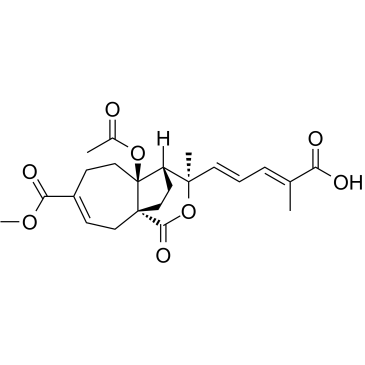In vitro synergy of pseudolaric acid B and fluconazole against clinical isolates of Candida albicans.
Na Guo, Guanghui Ling, Xiaoying Liang, Jing Jin, Junwen Fan, Jiazhang Qiu, Yu Song, Ning Huang, Xiuping Wu, Xuelin Wang, Xuming Deng, Xuliang Deng, Lu Yu
Index: Mycoses 54(5) , e400-6, (2011)
Full Text: HTML
Abstract
Candida albicans is the most common fungal pathogen in humans. The emergence of resistance to azole antifungals has raised the issue of using such antifungals in combination to optimise therapeutic outcome. The objective of this study was to evaluate in vitro synergy of pseudolaric acid B (PAB) and fluconazole (FLC) against clinical isolates of C. albicans. The in vitro antifungal activity of PAB, a diterpene acid from Pseudolarix kaempferi Gordon, was evaluated alone and in combination with FLC against 22 FLC-resistant (FLC-R) and 12 FLC-susceptible (FLC-S) C. albicans using the chequerboard microdilution method and time-killing test assays. Synergism was observed in all 22 (100%) FLC-R strains tested as determined by both fractional inhibitory concentration index (FICI) with values ranging from 0.02 to 0.13 and bliss independence (BI) models. Synergism was observed in two of 12 (17%) FLC-S strains as determined by FICI model with values ranging from 0.25 to 0.5 and in three of 12 (18%) FLC-S strains as determined by BI model. For FLC-R strains, the drug concentrations of FLC and PAB, where synergistic interactions were found, ranged from 0.06 to 4 μg ml(-1) and 0.5 to 4 μg ml(-1) respectively. For FLC-S strains, the drug concentrations of FLC and PAB were 1-8 μg ml(-1) and 0.5-4 μg ml(-1) respectively. The BI model gave results consistent with FICI, but no antagonistic activity was observed in any of the strains tested. These interactions between PAB and FLC were confirmed using the time-killing test for the selected strains. Fluconazole and PAB exhibited a good synergism against azole-R isolates of C. albicans.© 2010 Blackwell Verlag GmbH.
Related Compounds
| Structure | Name/CAS No. | Molecular Formula | Articles |
|---|---|---|---|
 |
Pseudolaric acid B
CAS:82508-31-4 |
C23H28O8 |
|
Newly discovered angiogenesis inhibitors and their mechanism...
2012-09-01 [Acta Pharmacol. Sin. 33(9) , 1103-11, (2012)] |
|
Bcl-2 family proteins were involved in pseudolaric acid B-in...
2008-07-01 [J. Pharmacol. Sci. 107(3) , 295-302, (2008)] |
|
Preparative isolation of pseudolaric acids A and B, and thei...
2009-01-01 [J. Sep. Sci. 32(2) , 309-13, (2009)] |
|
Effects of PLAB on apoptosis and Smad signal pathway of hype...
2008-01-01 [J. Asian Nat. Prod. Res. 10(1-2) , 147-57, (2008)] |
|
Topical application of Pseudolaric acid B improve DNFB-induc...
2012-04-11 [Eur. J. Pharm. Sci. 45(5) , 668-76, (2012)] |